France
At A glance
Capital City: Paris
Land size: 549,970 sq km (metropolitan France)
Population: 68,305,148 (2022 est.)
Official language: French
Currency: Euro (€ / EUR)
UNESCO properties and sites:
- Abbey Church of Saint-Savin sur Gartempe
- Amiens Cathedral
- Arles (Roman and Romanesque Monuments)
- Belfries of Belgium and France
- Bordeaux (Port of the Moon)
- Bourges Cathedral
- Canal du Midi
- Cathedral of Notre-Dame (Former Abbey of Saint-Rémi and Palace of Tau) in Reims
- Champagne Hillsides (Houses and Cellars)
- Chartres Cathedral
- Cistercian Abbey of Fontenay
- Cordouan Lighthouse
- Decorated Cave of Pont d’Arc (known as Grotte Chauvet-Pont d’Arc) in Ardèche
- Episcopal City of Albi
- Fortifications of Vauban
- From the Great Saltworks of Salins-les-Bains to the Royal Saltworks of Arc-et-Senans (the Production of Open-pan Salt)
- Historic Centre of Avignon (Papal Palace, Episcopal Ensemble and Avignon Bridge)
- Historic Fortified City of Carcassonne
- Historic Site of Lyon
- Jurisdiction of Saint-Emilion
- Le Havre (City Rebuilt by Auguste Perret)
- Mont-Saint-Michel and its Bay
- Nice (Winter Resort Town of the Riviera)
- Nord-Pas de Calais Mining Basin
- Palace and Park of Fontainebleau
- Palace and Park of Versailles
- Paris (Banks of the Seine)
- Nancy (Place Stanislas, Place de la Carrière and Place d'Alliance)
- Pont du Gard (Roman Aqueduct)
- Prehistoric Pile Dwellings around the Alps
- Prehistoric Sites and Decorated Caves of the Vézère Valley
- Provins (Town of Medieval Fairs)
- Roman Theatre and its Surroundings and the "Triumphal Arch" of Orange
- Routes of Santiago de Compostela in France
- Strasbourg (Grande-Île and Neustadt)
- Taputapuatea in French Polynesia
- The Architectural Work of Le Corbusier (an Outstanding Contribution to the Modern Movement)
- The Causses and the Cévennes (Mediterranean agro-pastoral Cultural Landscape)
- The Climats (terroirs of Burgundy)
- The Great Spa Towns of Europe
- The Loire Valley between Sully-sur-Loire and Chalonnes
- Vézelay (Church and Hill)
- Ancient and Primeval Beech Forests of the Carpathians and Other Regions of Europe
- Chaîne des Puys (Limagne fault tectonic arena)
- French Austral Lands and Seas
- Gulf of Porto (Calanche of Piana, Gulf of Girolata, Scandola Reserve) in Corsica
- Lagoons of New Caledonia (Reef Diversity and Associated Ecosystems)
- Reunion Island (Pitons, cirques and remparts)
- Pyrénées (Mont Perdu)
Source: https://www.cia.gov/the-world-factbook/countries/france/
France is a wonderful holiday destination thanks to its rich history, exquisite cuisine, and timeless beauty. Explore the enchanting streets of Paris, with its iconic landmarks like the Eiffel Tower, Louvre Museum, and Notre-Dame Cathedral. Discover the charming countryside of Provence, with its lavender fields, vineyards, and picturesque villages. Indulge in the exquisite flavors of French cuisine, from buttery croissants to delectable wines and mouthwatering cheeses. Immerse yourself in the art, culture, and romance that permeate every corner of this beautiful country.
France is also a great place to ride because of its diverse terrains and long-standing equestrian traditions. Explore the stunning coastline of the Landes region on horseback, feeling the gentle sea breeze as you traverse sandy beaches and ride through pine forests. Venture into the majestic vineyards, where rolling hills and small villages create an idyllic setting for unforgettable horse riding adventures. Experience the equestrian elegance of the Loire Valley, renowned for its prestigious castles.
Whether you're an experienced rider seeking thrilling trail rides or a beginner looking to connect with nature, France has something for you.
Brief History
France today plays an influential global role as a permanent member of the United Nations Security Council, NATO, the G-7, the G-20, the EU, and other multilateral organizations. France rejoined NATO's integrated military command structure in 2009, reversing DE GAULLE's 1966 decision to withdraw French forces from NATO.
Since 1958, it has constructed a hybrid presidential-parliamentary governing system resistant to the instabilities experienced in earlier, more purely parliamentary administrations. In recent decades, its reconciliation and cooperation with Germany have proved central to the economic integration of Europe, including the introduction of a common currency, the euro, in January 1999.
Source: https://www.cia.gov/the-world-factbook/countries/france/
Cultural Insights
Food plays a major role in the country's social life. Wine and cheese are sources of national pride and reflect regional differences. Meals are ritualized, and full of social and cultural meaning.
The three main meals are le petit déjeuner (breakfast), le déjeuner (lunch), and le dîner (dinner). Although the midday meal had great importance in an agricultural economy and is still the main meal in rural areas, there is a tendency for families to eat the largest meal in the evening. Breakfast is a light meal of bread, cereal, yogurt, and coffee or hot chocolate. Lunch and dinner generally involve several courses, at minimum a first course ( l'entree ) and a main dish ( le plat ), followed by cheese and/or dessert. In restaurants, it is common to have a price that includes all these courses, with a choice of dishes.
Children eat a snack after school, le goûter or quatre-heures, which usually includes cookies, bread and jam or chocolate, and a drink.
Meals involve a succession of courses eaten one at a time. A typical family meal starts with a soup, followed by vegetables and a meat dish and then a salad, cheese, and dessert. Wine is commonly served at meals. Most daily food preparation is done by wives and mothers in family settings even if both spouses work full-time.
In general when people greet each other, they shake hands or embrace with a kiss on both cheeks (called
faire la bise). Kissing is only done when two people are close friends or relatives. For the most part, the embrace is done only the first time in a day in which one sees someone and is not repeated again until one says good-bye.
There is also formality in verbal greetings, so that one shows respect by adding "Madame," "Monsieur," or "Mademoiselle" to any greeting.
There are important public and private distinctions. In public spaces, one generally does not smile at strangers or make eye contact with them (for instance, in the subway or bus) and should keep one's voice low when speaking. Privacy is also maintained in homes, so that doors to bedrooms and bathrooms are kept closed.
When shopping in smaller stores, the buyer generally greets the proprietor upon entry, and the proprietor helps the client choose the goods to be purchased. It is less common to have free access in a store, although the growth of large hypermarkets and shopping malls is changing this custom.
Source: https://www.everyculture.com/Cr-Ga/France.html
Transportation
By Air
There are numerous airlines available to you according to your country of departure. The main airlines though are Air France / KLM , British Airways, Lufthansa as well as the low cost carriers (EasyJet, Ryanair, Volare etc).
France is very well serviced with airports, both large and small. The largest are situated in the major cities and serve as international bases. If you come by air, there’s a good chance you’ll land in Paris. However, several other cities also have an international airport: Bordeaux, Lyon, Marseille, Nice, Strasbourg, Toulouse... and these cities also have good air links with Paris.
Paris-Charles de Gaulle (often called "Roissy") is the main international gateway to France and a major aviation hub in Europe. Among the largest airports in the world, Charles de Gaulle is located to the north of Paris and is continental Europe's busiest airport.
By Rail
Many trains (with trips during the day and overnight) connect France to other major cities in Europe.
To plan your itinerary and make reservations, you can visit Rail Europe (
https://www.raileurope.com/?utm_source=page&utm_medium=page&utm_campaign=francefr ) 's website, which combines schedules and fares from over 50 companies across Europe.
The TGV rail network links seamlessly with the national rail networks of neighboring countries, allowing you to reach France from London, Brussels, Barcelona, Geneva, Milan, and more in just a few hours.
Source: https://us.france.fr/en/holiday-prep/coming-to-france-by-train-0
https://centreforaviation.com/data/profiles/airports/paris-charles-de-gaulle-airport-cdg
https://us.france.fr/en/holiday-prep/flying-into-france
Money
Take sensible precautions and remain alert when handling cash and credit cards in public areas and at cash machines.
Credit cards are widely accepted. You may be asked to provide ID if you can’t pay by chip and PIN.
Source: https://www.gov.uk/foreign-travel-advice/france
Health
If you need emergency medical assistance during your trip, dial 112 for an English speaking emergency service and ask for an ambulance. If you are referred to a medical facility for treatment you should contact your insurance/medical assistance company immediately.
Ambulance services are widely available, though English is not widely spoken.
Medical care is comparable to that found in the United States.
Except for emergency services, you may be required to pay for service prior to receiving treatment in France. Be sure to obtain a “Feuille de Soins” for later reimbursement from your health care provider.
Source: https://www.gov.uk/foreign-travel-advice/france
https://travel.state.gov/content/travel/en/international-travel/International-Travel-Country-Information-Pages/France.html
Electricity
France operates on a 230V supply voltage and uses type C and E plugs.
The Type C electrical plug (or Europlug) is a two-wire plug that has two round pins. It fits into any socket that accepts 4.0 – 4.8 mm round contacts on 19 mm centres. They are being replaced by E, F, J, K or N sockets which work perfectly with Type C plugs.
The Type E electrical plug has two 4.8 mm round pins spaced 19 mm apart and a hole for the socket's male earthing pin. The Type E plug has a rounded shape and the Type E socket has a round recess.
The CEE 7/7 plug was developed to work with Type E and Type F sockets with a female contact (to accept the earthing pin of the Type E socket) and has earthing clips on both sides (to work with Type F sockets).
Source: https://www.iec.ch/world-plugs
Communication
Time zone in mainland France: Central European Standard Time (GMT+1)
International country code – 33
France's telecom market is one of the largest in Europe.
LTE networks provide near universal coverage, and carry about 95% of mobile data traffic. Operators have launched 5G services, and these have been supported by the late-2020 auction of spectrum in the 3.5GHz range.
France’s fixed broadband market is increasingly focused on fiber, which accounted for 71% of all fixed lines at the beginning of 2021.
Source:
https://www.cia.gov/the-world-factbook/countries/france/
Phrasebook
| English |
French |
| Hello! |
Bonjour |
| Goodbye |
Au Revoir |
| Good morning |
Bonjour |
| Good evening |
Bonsoir |
| Good night |
Bonne nuit |
| Please |
S'il vous plait |
| Thank you |
Merci |
| Yes |
Oui |
| No |
Non |
Source: https://www.linguahouse.com/phrasebooks/english-french
Entry Requirements
Generally, unless exempted, a VISA is required. It must be acquired before departure for France at the relevant French embassy or consulate in the applicant’s country of residence. The type of VISA required to enter France depends on both the duration and reasons for the intended stay.
For stays of less than 90 days (3 months), the VISA to be requested is a short-stay VISA called "Schengen VISA".
The EU Regulation 539/2001 removes the need for certain foreign nationals to obtain a short-stay VISA when entering the Schengen area.
Depending on your personal situation, specific measures of the law of the European Union are applied:
- Nationals of EU Member States, the European Economic Area or Switzerland are not subject to entry visas and residence permits, regardless of length of stay.
- Family members (partner, dependent children, dependent ascendants) of an EU Member State citizen, the EEA or Switzerland (who are not themselves citizens of an EU Member State, the EEA or Switzerland) are subject to the same visa and other permit rules as other foreigners of their nationality.
You can click on the link below in order to heck if you need to apply to a visa or not:
https://france-visas.gouv.fr/web/france-visas/ai-je-besoin-d-un-visa
Source: https://us.france.fr/en/holiday-prep/customs-and-visas-1
Embassies and Consulates
U.S. Embassy in Paris
2 avenue Gabriel
75008 Paris
Phone: +33 (0) 143 12 22 22
U.S. Consulate in Bordeaux
89 Quai des Chartrons
33300 Bordeaux
Phone.: +33 (0) 143 12 48 65
U.S. Consulate in Lyon
Espace Cordeliers
2, rue Président Carnot
69002 Lyon
Phone: +33 (0) 143 12 48 60
U.S. Consulate General in Marseille
Place Varian Fry
13286 Marseille Cedex 6
Phone : +33 (0) 143 12 47 54
U.S. Consulate in Rennes
P30, Quai Duguay-Trouin
35000 Rennes
Phone: +33 (0) 143 12 48 70
U.S. Consulate General in Strasbourg
15, Avenue d’Alsace
67082 Strasbourg
Phone: +33 (0) 143 12 48 80
Embassy of Canada in Paris
130, rue du Faubourg Saint-Honoré
75008 Paris
Phone: +33 (0) 144 43 29 02
Consulate of Canada in Nice
37, boulevard Dubouchage – 1st floor
06000 Nice
Phone: +33 (0) 493 13 17 19
Consulate of Canada in Lyon
3, place de la Bourse
69002 Lyon
Phone: +33 (0) 478 84 39 19
Source: for USA https://www.usembassy.gov/
For Canada: https://travel.gc.ca/assistance/embassies-consulates
UNESCO Sites
Abbey Church of Saint-Savin sur Gartempe
Located in the Nouvelle-Aquitaine region, the Abbey Church of Saint-Savin-sur-Gartempe, is an ancient abbey founded or refounded during the Carolingian era by Saint Benoît d’Aniane, father of western monasticism, under the protection of Charlemagne and his successors. Rebuilt in the 11th century, it bears witness to western Roman architecture with its well-balanced volumes. Its murals, executed at the end of the 11th or early 12th century, are an exceptional ensemble of medieval imagery. The edifice is mounted by a Gothic spire, of almost 80 metres in height, dating from the 14th century and reconstructed in the 19th century.
The pictoral presentation in the Abbey Church of Saint-Savin consists in an immense biblical narrative thematically organized and visually evident in all parts of the church. An initial pictoral cycle covering the vault of the “clocher-porche” and the tympanum of the doorway opening into the church describes the Apocalypse in imposing scenes. A second series of biblical subjects is spread across the entire barrel-vaulting of the central nave. The Passion of Christ is painted in the upper tribune of the porch, with scenes of the martyrs. Large figures of the saints are found in the choir and on the piers of the transept. Finally, the story of the Saints Savin and Cyprian covers the walls of the crypt that bears their names. This decoration makes this building an exceptional testimony to medieval tradition when churches were painted.
Amiens Cathedral
Amiens Cathedral, in the heart of Picardy, is one of the largest 'classic' Gothic churches of the 13th century. It is notable for the coherence of its plan, the beauty of its three-tier interior elevation and the particularly fine display of sculptures on the principal façade and in the south transept.
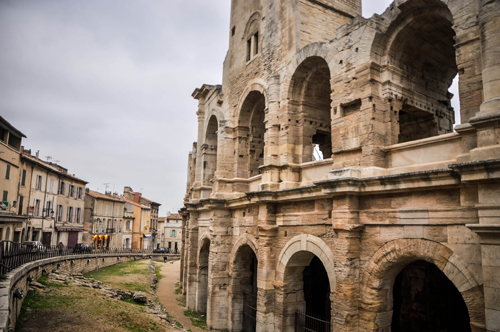 Photo by Camille Loiseau
Arles
Photo by Camille Loiseau
Arles (Roman and Romanesque Monuments)
Arles is a good example of the adaptation of an ancient city to medieval European civilization. It has some impressive Roman monuments, of which the earliest – the arena, the Roman theatre and the cryptoporticus (subterranean galleries) – date back to the 1st century B.C. During the 4th century Arles experienced a second golden age, as attested by the baths of Constantine and the necropolis of Alyscamps. In the 11th and 12th centuries, Arles once again became one of the most attractive cities in the Mediterranean. Within the city walls, Saint-Trophime, with its cloister, is one of Provence's major Romanesque monuments.
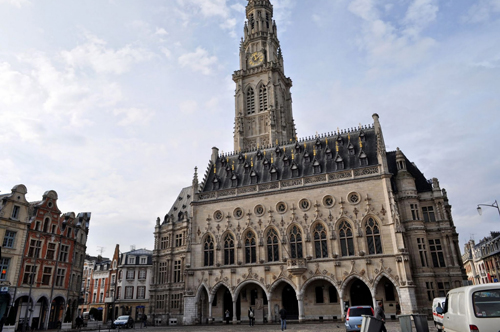 Photo by Camille Loiseau
Belfries of Belgium and France
Photo by Camille Loiseau
Belfries of Belgium and France
Twenty-three belfries in the north of France were inscribed in 2005, as an extension to the 32 Belgian belfries inscribed in 1999 as Belfries of Flanders and Wallonia. Built between the 11th and 17th centuries, they showcase the Roman, Gothic, Renaissance and Baroque styles of architecture. They are highly significant tokens of the winning of civil liberties. While Italian, German and English towns mainly opted to build town halls, in part of north-western Europe, greater emphasis was placed on building belfries. Compared with the keep (symbol of the seigneurs) and the bell-tower (symbol of the Church), the belfry, the third tower in the urban landscape, symbolizes the power of the aldermen. Over the centuries, they came to represent the influence and wealth of the towns.
Bordeaux (Port of the Moon)
The Port of the Moon, port city of Bordeaux in south-west France, is inscribed as an inhabited historic city, an outstanding urban and architectural ensemble, created in the age of the Enlightenment, whose values continued up to the first half of the 20th century, with more protected buildings than any other French city except Paris. It is also recognized for its historic role as a place of exchange of cultural values over more than 2,000 years, particularly since the 12th century due to commercial links with Britain and the Low Lands. Urban plans and architectural ensembles of the early 18th century onwards place the city as an outstanding example of innovative classical and neoclassical trends and give it an exceptional urban and architectural unity and coherence. Its urban form represents the success of philosophers who wanted to make towns into melting pots of humanism, universality and culture.
Bourges Cathedral
The Cathedral of St Etienne of Bourges, built between the late 12th and late 13th centuries, is one of the great masterpieces of Gothic art and is admired for its proportions and the unity of its design. The tympanum, sculptures and stained-glass windows are particularly striking. Apart from the beauty of the architecture, it attests to the power of Christianity in medieval France.
Canal du Midi
This 360-km network of navigable waterways linking the Mediterranean and the Atlantic through 328 structures (locks, aqueducts, bridges, tunnels, etc.) is one of the most remarkable feats of civil engineering in modern times. Built between 1667 and 1694, it paved the way for the Industrial Revolution. The care that its creator, Pierre-Paul Riquet, took in the design and the way it blends with its surroundings turned a technical achievement into a work of art.
Cathedral of Notre-Dame (Former Abbey of Saint-Rémi and Palace of Tau)
in Reims
The outstanding handling of new architectural techniques in the 13th century, and the harmonious marriage of sculptural decoration with architecture, has made Notre-Dame in Reims one of the masterpieces of Gothic art. The former abbey still has its beautiful 9th-century nave, in which lie the remains of Archbishop St Rémi (440–533), who instituted the Holy Anointing of the kings of France. The former archiepiscopal palace known as the Tau Palace, which played an important role in religious ceremonies, was almost entirely rebuilt in the 17th century.
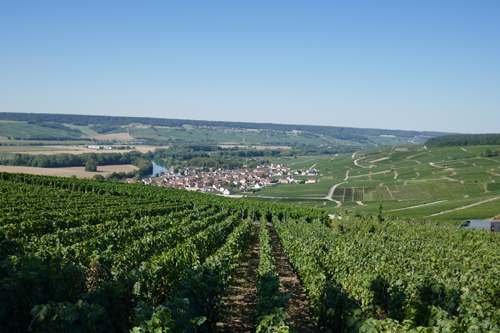 Champagne Hillsides
Champagne Hillsides (Houses and Cellars)
The property encompasses sites where the method of producing sparkling wines was developed on the principle of secondary fermentation in the bottle since the early 17th century to its early industrialization in the 19th century. The property is made up of three distinct ensembles: the historic vineyards of Hautvillers, Aÿ and Mareuil-sur-Aÿ, Saint-Nicaise Hill in Reims, and the Avenue de Champagne and Fort Chabrol in Epernay. These three components – the supply basin formed by the historic hillsides, the production sites (with their underground cellars) and the sales and distribution centres (the Champagne Houses) - illustrate the entire champagne production process. The property bears clear testimony to the development of a very specialized artisan activity that has become an agro-industrial enterprise.
Chartres Cathedral
Partly built starting in 1145, and then reconstructed over a 26-year period after the fire of 1194, Chartres Cathedral marks the high point of French Gothic art. The vast nave, in pure ogival style, the porches adorned with fine sculptures from the middle of the 12th century, and the magnificent 12th- and 13th-century stained-glass windows, all in remarkable condition, combine to make it a masterpiece.
Cistercian Abbey of Fontenay
This stark Burgundian monastery was founded by St Bernard in 1119. With its church, cloister, refectory, sleeping quarters, bakery and ironworks, it is an excellent illustration of the ideal of self-sufficiency as practised by the earliest communities of Cistercian monks.
Cordouan Lighthouse
The Lighthouse of Cordouan rises up on a shallow rocky plateau in the Atlantic Ocean at the mouth of the Gironde estuary in the Nouvelle-Aquitaine region, in a highly exposed and hostile environment. Built in white limestone dressed blocks at the turn of the 16th and 17th centuries, it was designed by engineer Louis de Foix and remodelled by engineer Joseph Teule`re in the late 18th century. A masterpiece of maritime signalling, Cordouan’s monumental tower is decorated with pilasters, columns modillions and gargoyles. It embodies the great stages of the architectural and technological history of lighthouses and was built with the ambition of continuing the tradition of famous beacons of antiquity, illustrating the art of building lighthouses in a period of renewed navigation, when beacons played an important role as territorial markers and as instruments of safety. Finally, the increase of its height, in the late 18th century, and the changes to its light chamber, attest to the progress of science and technology of the period. Its architectural forms drew inspiration from ancient models, Renaissance Mannerism and the specific architectural language of France’s engineering school Ecole des Ponts et Chaussees.
Decorated Cave of Pont d’Arc (known as Grotte Chauvet-Pont d’Arc)
in Ardèche
Located in a limestone plateau of the Ardèche River in southern France, the property contains the earliest-known and best-preserved figurative drawings in the world, dating back as early as the Aurignacian period (30,000–32,000 BP), making it an exceptional testimony of prehistoric art. The cave was closed off by a rock fall approximately 20,000 years BP and remained sealed until its discovery in 1994, which helped to keep it in pristine condition. Over 1,000 images have so far been inventoried on its walls, combining a variety of anthropomorphic and animal motifs. Of exceptional aesthetic quality, they demonstrate a range of techniques including the skilful use of shading, combinations of paint and engraving, anatomical precision, three-dimensionality and movement. They include several dangerous animal species difficult to observe at that time, such as mammoth, bear, cave lion, rhino, bison and auroch, as well as 4,000 inventoried remains of prehistoric fauna and a variety of human footprints.
Episcopal City of Albi
On the banks of the Tarn river in south-west France, the old city of Albi reflects the culmination of a medieval architectural and urban ensemble. Today the Old Bridge (Pont-Vieux), the Saint-Salvi quarter and its church are testimony to its initial development (10th -11th centuries). Following the Albigensian Crusade against the Cathar heretics (13th century) it became a powerful episcopal city. Built in a unique southern French Gothic style from local brick in characteristic red and orange colours, the lofty fortified Cathedral (late 13th century) dominates the city, demonstrating the power regained by the Roman Catholic clergy. Alongside the Cathedral is the vast bishop’s Palais de la Berbie, overlooking the river and surrounded by residential quarters that date back to the Middle Ages. The Episcopal City of Albi forms a coherent and homogeneous ensemble of monuments and quarters that has remained largely unchanged over the centuries.
Fortifications of Vauban
Fortifications of Vauban consists of 12 groups of fortified buildings and sites along the western, northern and eastern borders of France. They represent the finest examples of the work of Sébastien Le Prestre de Vauban (1633-1707), a military engineer of King Louis XIV. The serial property includes towns built from scratch by Vauban, citadels, urban bastion walls and bastion towers. There are also mountain forts, sea forts, a mountain battery and two mountain communication structures. This property is inscribed as bearing witness to the peak of classic fortifications, typical of western military architecture. Vauban also played a major role in the history of fortification in Europe and on other continents until the mid-19th century.
From the Great Saltworks of Salins-les-Bains to the Royal Saltworks of Arc-et-Senans (the Production of Open-pan Salt)
The Royal Saltworks of Arc-et-Senans, near Besançon, was built by Claude Nicolas Ledoux. Its construction, begun in 1775 during the reign of Louis XVI, was the first major achievement of industrial architecture, reflecting the ideal of progress of the Enlightenment. The vast, semicircular complex was designed to permit a rational and hierarchical organization of work and was to have been followed by the building of an ideal city, a project that was never realized.
The Great Saltworks of Salins-les-Bains was active for at least 1200 years until stopping activity in 1962. From 1780 to 1895, its salt water travelled through 21 km of wood pipes to the Royal Saltworks of Arc-et-Senans. It was built near the immense Chaux Forest to ensure its supply of wood for fuel. The Saltworks of Salins shelters an underground gallery from the 13th century including a hydraulic pump from the 19th century that still functions. The boiler house demonstrates the difficulty of the saltworkers’ labour to collect the “White Gold”.
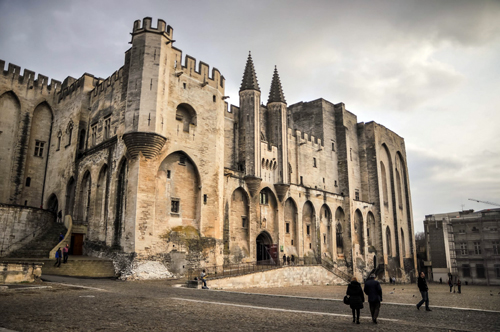 Photo by Camille Loiseau
Photo by Camille Loiseau
Historic Centre of Avignon (Papal Palace, Episcopal Ensemble and Avignon Bridge)
In the 14th century, this city in the South of France was the seat of the papacy. The Palais des Papes, an austere-looking fortress lavishly decorated by Simone Martini and Matteo Giovanetti, dominates the city, the surrounding ramparts and the remains of a 12th-century bridge over the Rhone. Beneath this outstanding example of Gothic architecture, the Petit Palais and the Romanesque Cathedral of Notre-Dame-des-Doms complete an exceptional group of monuments that testify to the leading role played by Avignon in 14th-century Christian Europe.
Historic Fortified City of Carcassonne
Since the pre-Roman period, a fortified settlement has existed on the hill where Carcassonne now stands. In its present form it is an outstanding example of a medieval fortified town, with its massive defences encircling the castle and the surrounding buildings, its streets and its fine Gothic cathedral. Carcassonne is also of exceptional importance because of the lengthy restoration campaign undertaken by Viollet-le-Duc, one of the founders of the modern science of conservation.
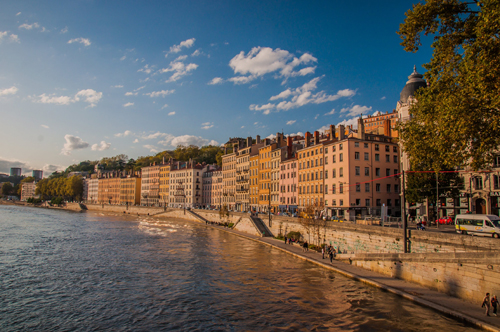 Photo by Camille Loiseau
Photo by Camille Loiseau
Historic Site of Lyon
Since the pre-Roman period, a fortified settlement has existed on the hill where Carcassonne now stands. In its present form it is an outstanding example of a medieval fortified town, with its massive defences encircling the castle and the surrounding buildings, its streets and its fine Gothic cathedral. Carcassonne is also of exceptional importance because of the lengthy restoration campaign undertaken by Viollet-le-Duc, one of the founders of the modern science of conservation.
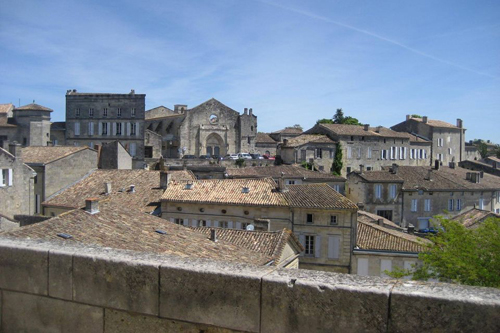 Jurisdiction of Saint-Emilion
Jurisdiction of Saint-Emilion
Viticulture was introduced to this fertile region of Aquitaine by the Romans, and intensified in the Middle Ages. The Saint-Emilion area benefited from its location on the pilgrimage route to Santiago de Compostela and many churches, monasteries and hospices were built there from the 11th century onwards. It was granted the special status of a 'jurisdiction' during the period of English rule in the 12th century. It is an exceptional landscape devoted entirely to wine-growing, with many fine historic monuments in its towns and villages.
Le Havre (City Rebuilt by Auguste Perret)
The city of Le Havre, on the English Channel in Normandy, was severely bombed during the Second World War. The destroyed area was rebuilt according to the plan of a team headed by Auguste Perret, from 1945 to 1964. The site forms the administrative, commercial and cultural centre of Le Havre. Le Havre is exceptional among many reconstructed cities for its unity and integrity. It combines a reflection of the earlier pattern of the town and its extant historic structures with the new ideas of town planning and construction technology. It is an outstanding post-war example of urban planning and architecture based on the unity of methodology and the use of prefabrication, the systematic utilization of a modular grid, and the innovative exploitation of the potential of concrete.
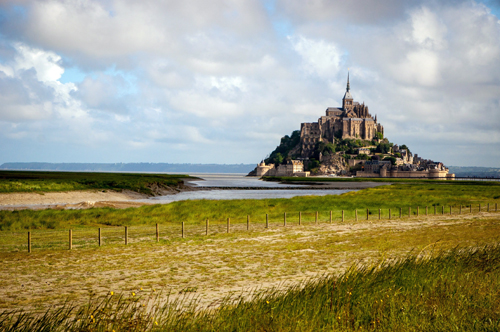 Photo by Camille Loiseau
Mont-Saint-Michel and its Bay
Photo by Camille Loiseau
Mont-Saint-Michel and its Bay
Perched on a rocky islet in the midst of vast sandbanks exposed to powerful tides between Normandy and Brittany stand the 'Wonder of the West', a Gothic-style Benedictine abbey dedicated to the archangel St Michael, and the village that grew up in the shadow of its great walls. Built between the 11th and 16th centuries, the abbey is a technical and artistic tour de force, having had to adapt to the problems posed by this unique natural site.
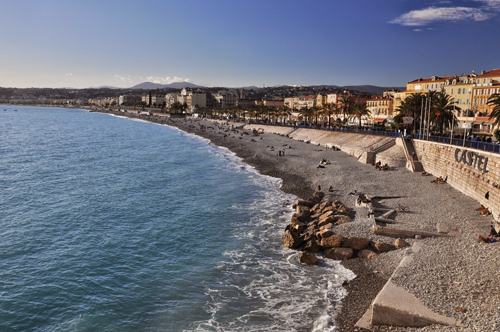 Photo by Camille Loiseau
Nice
Photo by Camille Loiseau
Nice (Winter Resort Town of the Riviera)
Nice, located on the Mediterranean, at the foot of the Alps, near the Italian border, in the Provence-Alpes-Côte d’Azur region, reflects the development of a city devoted to winter tourism, making the most of its mild climate and its coastal situation, between sea and mountains. From the mid-18th century, the site attracted growing numbers of aristocratic and upper-class families, mainly British, who developed the habit of spending their winters there. In 1832, Nice, then part of the Kingdom of Sardinia, set up the “Consiglio d’Ornato” which drew up a city planning scheme and architectural requirements designed to make the city attractive to foreigners. Thus, the “Camin dei Ingles”, a modest path which had been created along the coastline by British winter visitors in 1824, subsequently became the prestigious Promenade des Anglais. After the city was ceded to France in 1860, and thanks to its connection to the European rail network, an increasing number of winter visitors from all countries flocked to the city. This led to successive phases of development of new districts beyond the medieval old town. The diverse cultural influences of the winter visitors and the desire to make the most of the weather conditions and the coastal landscape have shaped the urban development and eclectic architectural styles of these districts, contributing to Nice’s reputation as a cosmopolitan winter resort.
Nord-Pas de Calais Mining Basin
Remarkable as a landscape shaped over three centuries of coal extraction from the 1700s to the 1900s, the site consists of 109 separate components over 120,000 ha. It features mining pits (the oldest of which dates from 1850) and lift infrastructure, slag heaps (some of which cover 90 ha and exceed 140 m in height), coal transport infrastructure, railway stations, workers’ estates and mining villages including social habitat, schools, religious buildings, health and community facilities, company premises, owners and managers’ houses, town halls and more. The site bears testimony to the quest to create model workers’ cities from the mid 19th century to the 1960s and further illustrates a significant period in the history of industrial Europe. It documents the living conditions of workers and the solidarity to which it gave rise.
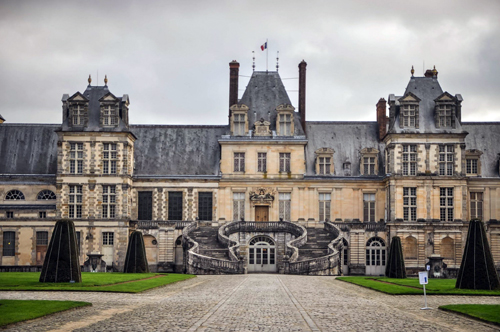 Photo by Camille Loiseau
Palace and Park of Fontainebleau
Photo by Camille Loiseau
Palace and Park of Fontainebleau
Used by the kings of France from the 12th century, the medieval royal hunting lodge of Fontainebleau, standing at the heart of a vast forest in the Ile-de-France, was transformed, enlarged and embellished in the 16th century by François I, who wanted to make a 'New Rome' of it. Surrounded by an immense park, the Italianate palace combines Renaissance and French artistic traditions.
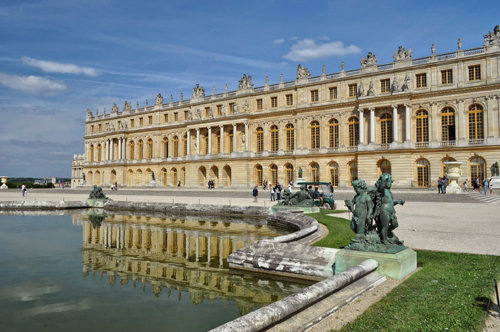 Photo by Camille Loiseau
Palace and Park of Versailles
Photo by Camille Loiseau
Palace and Park of Versailles
The Palace of Versailles was the principal residence of the French kings from the time of Louis XIV to Louis XVI. Embellished by several generations of architects, sculptors, decorators and landscape architects, it provided Europe with a model of the ideal royal residence for over a century.
 Photo by Camille Loiseau
Paris
Photo by Camille Loiseau
Paris (Banks of the Seine)
From the Louvre to the Eiffel Tower, from the Place de la Concorde to the Grand and Petit Palais, the evolution of Paris and its history can be seen from the River Seine. The Cathedral of Notre-Dame and the Sainte Chapelle are architectural masterpieces while Haussmann's wide squares and boulevards influenced late 19th- and 20th-century town planning the world over.
Nancy (Place Stanislas, Place de la Carrière and Place d'Alliance)
Nancy, the temporary residence of a king without a kingdom – Stanislas Leszczynski, later to become Duke of Lorraine – is paradoxically the oldest and most typical example of a modern capital where an enlightened monarch proved to be sensitive to the needs of the public. Built between 1752 and 1756 by a brilliant team led by the architect Héré, this was a carefully conceived project that succeeded in creating a capital that not only enhanced the sovereign's prestige but was also functional.
Pont du Gard (Roman Aqueduct)
The Pont du Gard was built shortly before the Christian era to allow the aqueduct of Nîmes (which is almost 50 km long) to cross the Gard river. The Roman architects and hydraulic engineers who designed this bridge, which stands almost 50 m high and is on three levels – the longest measuring 275 m – created a technical as well as an artistic masterpiece.
Prehistoric Pile Dwellings around the Alps
This serial property of 111 small individual sites encompasses the remains of prehistoric pile-dwelling (or stilt house) settlements in and around the Alps built from around 5000 to 500 B.C. on the edges of lakes, rivers or wetlands. Excavations, only conducted in some of the sites, have yielded evidence that provides insight into life in prehistoric times during the Neolithic and Bronze Age in Alpine Europe and the way communities interacted with their environment. Fifty-six of the sites are located in Switzerland. The settlements are a unique group of exceptionally well-preserved and culturally rich archaeological sites, which constitute one of the most important sources for the study of early agrarian societies in the region.
Prehistoric Sites and Decorated Caves of the Vézère Valley
This serial property of 111 small individual sites encompasses the remains of prehistoric pile-dwelling (or stilt house) settlements in and around the Alps built from around 5000 to 500 B.C. on the edges of lakes, rivers or wetlands. Excavations, only conducted in some of the sites, have yielded evidence that provides insight into life in prehistoric times during the Neolithic and Bronze Age in Alpine Europe and the way communities interacted with their environment. Fifty-six of the sites are located in Switzerland. The settlements are a unique group of exceptionally well-preserved and culturally rich archaeological sites, which constitute one of the most important sources for the study of early agrarian societies in the region.
Provins (Town of Medieval Fairs)
The fortified medieval town of Provins is situated in the former territory of the powerful Counts of Champagne. It bears witness to early developments in the organization of international trading fairs and the wool industry. The urban structure of Provins, which was built specifically to host the fairs and related activities, has been well preserved.
Roman Theatre and its Surroundings and the "Triumphal Arch" of Orange
The fortified medieval town of Provins is situated in the former territory of the powerful Counts of Champagne. It bears witness to early developments in the organization of international trading fairs and the wool industry. The urban structure of Provins, which was built specifically to host the fairs and related activities, has been well preserved.
Routes of Santiago de Compostela in France
Santiago de Compostela was the supreme goal for countless thousands of pious pilgrims who converged there from all over Europe throughout the Middle Ages. To reach Spain pilgrims had to pass through France, and the group of important historical monuments included in this inscription marks out the four routes by which they did so.
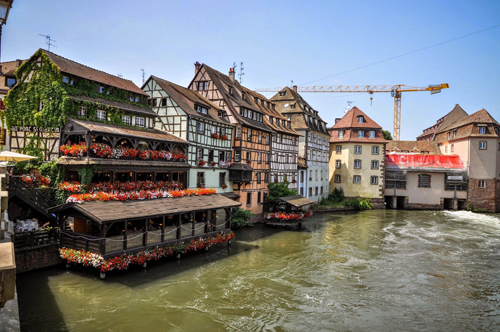 Photo by Camille Loiseau
Strasbourg
Photo by Camille Loiseau
Strasbourg (Grande-Île and Neustadt)
The initial property, inscribed in 1988 on the World Heritage List, was formed by the Grande-Île, the historic centre of Strasbourg, structured around the cathedral. The extension concerns the Neustadt, new town, designed and built under the German administration (1871-1918). The Neustadt draws the inspiration for its urban layout partially from the Haussmannian model, while adopting an architectural idiom of Germanic inspiration. This dual influence has enabled the creation of an urban space that is specific to Strasbourg, where the perspectives created around the cathedral open to a unified landscape around the rivers and canals.
Taputapuatea in French Polynesia
Taputapuatea on Ra’iatea Island is at the centre of the ‘Polynesian Triangle’, a vast portion of the Pacific Ocean, dotted with islands, and the last part of the globe to be settled by humans. The property includes two forested valleys, a portion of lagoon and coral reef and a strip of open ocean. At the heart of the property is the Taputapuatea marae complex, a political, ceremonial and funerary centre. It is characterized by several marae, with different functions. Widespread in Polynesia, the marae were places where the world of the living intersected the world of the ancestors and the gods. Taputapuatea is an exceptional testimony to 1,000 years of ma'ohi civilization.
The Architectural Work of Le Corbusier (an Outstanding Contribution to the Modern Movement)
Chosen from the work of Le Corbusier, the 17 sites comprising this transnational serial property are spread over seven countries and are a testimonial to the invention of a new architectural language that made a break with the past. They were built over a period of a half-century, in the course of what Le Corbusier described as “patient research”. The Complexe du Capitole in Chandigarh (India), the National Museum of Western Art, Tokyo (Japan), the House of Dr Curutchet in La Plata (Argentina) and the Unité d’habitation in Marseille (France) reflect the solutions that the Modern Movement sought to apply during the 20th century to the challenges of inventing new architectural techniques to respond to the needs of society. These masterpieces of creative genius also attest to the internationalization of architectural practice across the planet.
The Causses and the Cévennes (Mediterranean agro-pastoral Cultural Landscape)
This 302,319 ha property, in the southern part of central France, is a mountain landscape interspersed by deep valleys that is representative of the relationship between agro-pastoral systems and their biophysical environment, notably through drailles or drove roads. Villages and substantial stone farmhouses on deep terraces of the Causses reflect the organization of large abbeys from the 11th century. Mont Lozère, inside the property, is one of the last places where summer transhumance is still practiced in the traditional way, using the drailles.
The Climats (terroirs of Burgundy)
The climates are precisely delimited vineyard parcels on the slopes of the Côte de Nuits and the Côte de Beaune south of the city of Dijon. They differ from one another due to specific natural conditions (geology and exposure) as well as vine types and have been shaped by human cultivation. Over time they came to be recognized by the wine they produce. This cultural landscape consists of two parts. Firstly, the vineyards and associated production units including villages and the town of Beaune, which together represent the commercial dimension of the production system. The second part includes the historic centre of Dijon, which embodies the political regulatory impetus that gave birth to the climats system. The site is an outstanding example of grape cultivation and wine production developed since the High Middle Ages.
The Great Spa Towns of Europe
This transnational serial property comprises eleven spa towns, located in seven European countries: Baden bei Wien (Austria); Spa (Belgium); Frantis?kovy La´zne?; Karlovy Vary; Maria´nske´ La´zne? (Czechia); Vichy (France); Bad Ems; Baden-Baden; Bad Kissingen (Germany); Montecatini Terme (Italy); and City of Bath (United Kingdom). All of these towns developed around natural mineral water springs. They bear witness to the international European spa culture that developed from the early 18th century to the 1930s, leading to the emergence of grand international resorts that impacted urban typology around ensembles of spa buildings such as baths, kurhaus and kursaal (buildings and rooms dedicated to therapy), pump rooms, drinking halls, colonnades and galleries designed to harness the natural mineral water resources and to allow their practical use for bathing and drinking. Related facilities include gardens, assembly rooms, casinos, theatres, hotels and villas, as well as spa-specific support infrastructure. These ensembles are all integrated into an overall urban context that includes a carefully managed recreational and therapeutic environment in a picturesque landscape. Together, these sites embody the significant interchange of human values and developments in medicine, science and balneology.
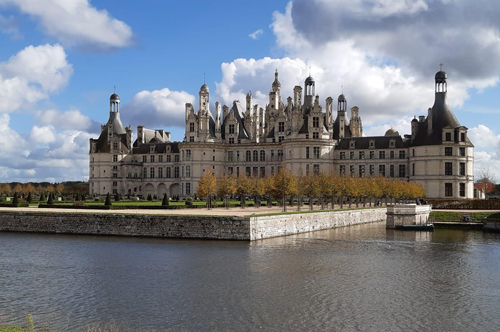
Photo by Camille Loiseau
The Loire Valley between Sully-sur-Loire and Chalonnes
The Loire Valley is an outstanding cultural landscape of great beauty, containing historic towns and villages, great architectural monuments (the châteaux), and cultivated lands formed by many centuries of interaction between their population and the physical environment, primarily the river Loire itself.
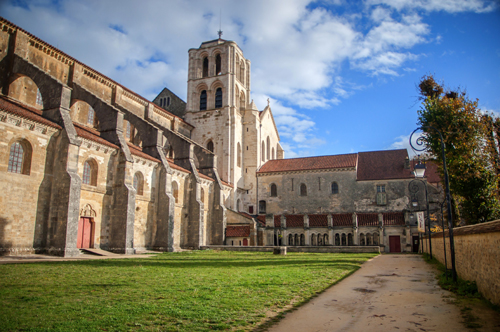
Photo by Camille Loiseau
Vézelay (Church and Hill)
Shortly after its foundation in the 9th century, the Benedictine abbey of Vézelay acquired the relics of St Mary Magdalene and since then it has been an important place of pilgrimage. St Bernard preached the Second Crusade there in 1146 and Richard the Lion-Hearted and Philip II Augustus met there to leave for the Third Crusade in 1190. With its sculpted capitals and portal, the Madeleine of Vézelay – a 12th-century monastic church – is a masterpiece of Burgundian Romanesque art and architecture.
Ancient and Primeval Beech Forests of the Carpathians and Other Regions of Europe
This transnational property includes 94 component parts in 18 countries. Since the end of the last Ice Age, European Beech spread from a few isolated refuge areas in the Alps, Carpathians, Dinarides, Mediterranean and Pyrenees over a short period of a few thousand years in a process that is still ongoing. The successful expansion across a whole continent is related to the tree’s adaptability and tolerance of different climatic, geographical and physical conditions.
Chaîne des Puys (Limagne fault tectonic arena)
Situated in the centre of France, the property comprises the long Limagne fault, the alignments of the Chaîne des Puys volcanoes and the inverted relief of the Montagne de la Serre. It is an emblematic segment of the West European Rift, created in the aftermath of the formation of the Alps, 35 million years ago. The geological features of the property demonstrate how the continental crust cracks, then collapses, allowing deep magma to rise and cause uplifting at the surface. The property is an exceptional illustration of continental break-up – or rifting – which is one of the five major stages of plate tectonics.
French Austral Lands and Seas
The French Austral Lands and Seas comprise the largest of the rare emerged landmasses in the southern Indian Ocean: the Crozet Archipelago, the Kerguelen Islands, Saint-Paul and Amsterdam Islands as well as 60 small sub-Antarctic islands. This ‘oasis’ in the middle of the Southern Ocean covers an area of more than 67 million ha and supports one of the highest concentrations of birds and marine mammals in the world. In particular, it has the largest population of King Penguins and Yellow-nosed albatrosses in the world. The remoteness of these islands from centres of human activity makes them extremely well-preserved showcases of biological evolution and a unique terrain for scientific research.
Gulf of Porto (Calanche of Piana, Gulf of Girolata, Scandola Reserve)
in Corsica
The nature reserve, which is part of the Regional Natural Park of Corsica, occupies the Scandola peninsula, an impressive, porphyritic rock mass. The vegetation is an outstanding example of scrubland. Seagulls, cormorants and sea eagles can be found there. The clear waters, with their islets and inaccessible caves, host a rich marine life.
Lagoons of New Caledonia (Reef Diversity and Associated Ecosystems)
This serial site comprises six marine clusters that represent the main diversity of coral reefs and associated ecosystems in the French Pacific Ocean archipelago of New Caledonia and one of the three most extensive reef systems in the world. These Lagoons are of exceptional natural beauty. They feature an exceptional diversity of coral and fish species and a continuum of habitats from mangroves to seagrasses with the world’s most diverse concentration of reef structures. The Lagoons of New Caledonia display intact ecosystems, with healthy populations of large predators, and a great number and diversity of big fish. They provide habitat to a number of emblematic or threatened marine species such as turtles, whales or dugongs whose population here is the third largest in the world.
Reunion Island (Pitons, cirques and remparts)
The Pitons, cirques and remparts of Reunion Island site coincides with the core zone of La Réunion National Park. The property covers more than 100,000 ha or 40 % of La Réunion, an island comprising two adjoining volcanic massifs located in the south-west of the Indian Ocean. Dominated by two towering volcanic peaks, massive walls and three cliff-rimmed cirques, the property includes a great variety of rugged terrain and impressive escarpments, forested gorges and basins creating a visually striking landscape. It is the natural habitat for a wide diversity of plants, presenting a high level of endemism. There are subtropical rainforests, cloud forests and heaths creating a remarkable and visually appealing mosaic of ecosystems and landscape features.
Pyrénées (Mont Perdu)
This outstanding mountain landscape, which spans the contemporary national borders of France and Spain, is centred around the peak of Mount Perdu, a calcareous massif that rises to 3,352 m. The site, with a total area of 30,639 ha, includes two of Europe's largest and deepest canyons on the Spanish side and three major cirque walls on the more abrupt northern slopes with France, classic presentations of these geological landforms. The site is also a pastoral landscape reflecting an agricultural way of life that was once widespread in the upland regions of Europe but now survives only in this part of the Pyrénées. Thus it provides exceptional insights into past European society through its landscape of villages, farms, fields, upland pastures and mountain roads.
Source: https://whc.unesco.org/en/statesparties/fr/